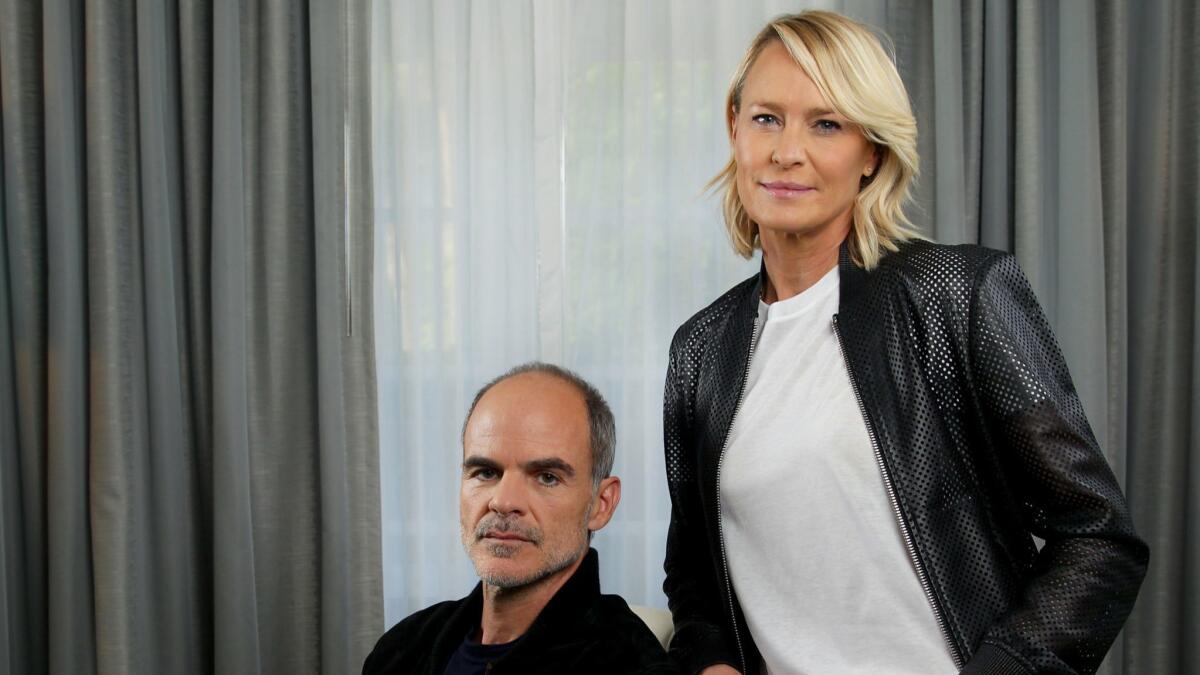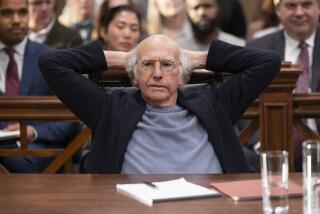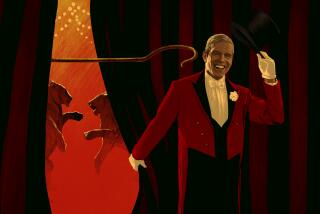With Kevin Spacey gone and Trump in the White House, ‘House of Cards’ finishes its run far from where it started

“There was a giant, wall-sized clock staring at us.”
Inside a sun-soaked Beverly Hills hotel room, Melissa James Gibson, co-showrunner of Netflix’s “House of Cards,” is seated across from her counterpart, Frank Pugliese, recounting the race to salvage the streaming giant’s flagship series last fall.
The political thriller was two weeks into production in Baltimore, on its sixth and final season — planned, but not yet announced as such — when the cards collapsed.
As the Harvey Weinstein scandal deepened and spread, actor Anthony Rapp accused Kevin Spacey, the show’s lead and executive producer, of making unwanted sexual advances on him when Rapp was a teen in the mid-1980s. Spacey issued a statement that pivoted from an apology for the incident, which he said he couldn’t remember, to a declaration that he chooses now to “live as a gay man”— but other accusers would soon come forward. Production on the show shut down. Spacey was fired. And producers were left scrambling to figure out if it was possible to reconfigure the series without its most formidable character. Spacey’s turn as ruthless and corrupt politician Francis “Frank” Underwood had long served as the show’s Machiavellian tour guide into the corrupt underbelly of government — often by speaking directly into the camera to viewers.
“We had already written or outlined 11 of the 13 episodes for that original version of Season 6,” Pugliese says. “We were well on our way in terms of the arc of the season. So it was —”
“It was a gut punch,” James Gibson finishes. “We had to just write as quickly as possible. There was no time to feel the pressure.”
The show had, in fact, reached a turning point at the end of Season 5, one that mirrored the larger theme surrounding the Time’s Up movement. Frank had resigned as president and his wife, Claire Underwood, played to icy distinction by Robin Wright, ascended from her perch as vice president to become the first female president. “My turn,” she declared to the audience in the closing seconds.
It easily could have passed as the show’s finale. But the prospect of a man’s alleged misconduct thwarting the exploration of a woman, albeit a fictional one, stepping into her power felt troubling.
“It was a lot to process,” Wright says. “The climate was so intense at the time. And it was at the forefront of the news — everywhere, everyone. Nobody knew how to handle it all, ethically and morally. What do we do? We had a lot of discussions, and I think collectively, just decided the right thing to do is finish out the show. Not only for the fans, but for these people that were so dedicated to making ‘House of Cards.’ I think we owed it to everyone.”
The reworked season, which was trimmed down to eight episodes, will get its public unveiling on Friday, Nov. 2 — just in time to jolt the public enough to hit the polls for the midterm elections — and it shoulders a heavy load. Not only must “House of Cards” attempt to seamlessly move on without its dominant character, it must also bring a satisfactory close to the show that put Netflix on the original programming map.
It was a lot to process. The climate was so intense at the time. And it was at the forefront of the news — everywhere, everyone. Nobody knew how to handle it.
— Robin Wright, star of “House of Cards”
“When we came back, it was like the foot was slamming on the gas,” says Michael Kelly, who portrays Frank’s taciturn right-hand man Doug Stamper. “There’s a different energy to the season. It feels heightened, with good reason.”
Last season saw the show’s calculating First Couple devise a plan: Frank, who was facing impeachment, would resign and, after the pair appeared estranged to the American public, his wife/newly installed POTUS would pardon him for the crimes he committed while in office. The move, he said, would position him to be part of “the power behind the power.” But Claire reneged on the agreement.
“What had been seeded was a battle for the narrative and sort of a civil war, essentially, between them,” James Gibson says. “To some degree, that still gets to be explored; it’s just in different terms.”
And though Wright’s president is very different from the one who currently occupies the actual office, Donald Trump, the questions raised by the show certainly feel relevant to the current Washington, D.C., landscape. “We had decided at the end of Season 5 that no matter what, part of this season would be an exploration about who owns the White House,” Pugliese says. “Who’s the power behind the power?”

The new season opens with Claire, now a widow and roughly 100 days into her presidency, behind her desk in the Oval Office, listening as a staff member reads her the litany of death threats and misogynistic critiques she’s received from the American public. And she’s unfazed.
Wright, who is an executive producer on the series and directed the final two episodes of the season, says watching Claire — long the assiduous wife whose ambitions were secondary to her husband’s — get her comeuppance and achieve power felt “comfortable.”
“It really did — because it’s been the trajectory from the beginning,” she says, then pauses. “The hardest part of stepping into that power was breaking the fourth wall and looking into the camera. That is not my home. It felt like I was in somebody else’s territory. But it’s funny how quickly you adapt to being in a powerful position as a character… will she succeed or not with her turn?”
“Claire is facing herself in a way that we’ve never seen before,” James Gibson says. “She’s completely out of the shadows.”
Frank’s absence also meant that the two greatest intimates in his life, Claire and Doug, were given room to develop in opposition to each other. “They are both each other’s downfall or salvation — or both at once, and that’s very dangerous and potent,” James Gibson says.
“Doug is completely lost without Frank,” Kelly explains. “Frank was his purpose, Frank was his drive — everything was about serving him. And with him gone, Doug is intent on preserving Frank’s legacy.”
“And it was always going to have to be a showdown between Claire and Stamper,” Wright adds. “Because Claire moves on. There’s no time for melancholia for her.”
The bedrock of the season — who pulls the puppet strings on the White House? — comes into focus through a pair of brother-sister wealthy corporate power brokers, Bill and Annette Shepherd, played by Greg Kinnear and Diane Lane. The characters are inspired by real-life conservative mega-donors the Koch brothers. Before his passing, it seems Frank shared some information with the family in exchange for wielding some of that power.
But do viewers want to sink deeper into the machinations of the world of politics right now?
We had decided at the end of Season 5 that no matter what, part of this season would be an exploration about who owns the White House.
— Frank Pugliese, “House of Cards” co-showrunner
Born during the Obama administration, the political series immediately drew recognition for mirroring the more corrupt side of government. But like most politically themed shows of this moment, the real-life twists and turns of the current administration often challenge any attempt to fictionalize modern American politics. Suddenly the theatrical vision of “House of Cards” looked startlingly like the news cycle.
“The show never tried to compete with real-life politics,” Pugliese says. “It just tries to be symptomatic of the culture of the moment and the politics of the moment. Throughout the whole show, it’s been interested in testing the seams of democracy or democratic institutions. How far can you push the edge until you reach the breaking point? And I think that is probably something where there is a parallel.”
So to hang it up now felt appropriate, Wright says. “We were running out of ideas. How do you trump that one — no pun intended? With our show, so often I think people are like, ‘That would never happen.’ The willing suspension of belief is thrown out the window. It definitely could happen [now].”
The show’s end also comes as Netflix, which it and Spacey helped establish as a purveyor of original content, seems intent on world domination.
Five years before Netflix was tying HBO for most Emmy wins this year (23 each) and spending billions upon billions on original series, the fast-growing company was bracing for the launch of its first original series. Long reliant on content from other studios (whether in renting DVDs of old movies and TV shows or being a hub for streaming it), Netflix banked on an adaptation of a British miniseries to be its entry point into original programming and its ambitions for dominance in Hollywood.
“House of Cards,” developed by Beau Willimon and directed, at least at the start, by film director David Fincher (“The Social Network”), made its debut in February 2013. And in a departure from its broadcast and cable brethren, it released all episodes in the season at the same time, a once-quaint notion. The show set in motion the rattling of traditional television, becoming the first streaming-only original series to get nominated in major Emmy categories in 2013. Over the course of its first five seasons, it nabbed 46 Emmy nominations and six wins.
Its conclusion — along with the recent announcement that “Orange Is the New Black,” another flagship series for Netflix, will end next year — brings a close to a defining chapter in the company’s push to be a global entertainment juggernaut.
“It was the series that really started it all for us in original programming,” says Cindy Holland, Netflix’s vice president of original content. “It wasn’t that long ago when content on the internet consisted of user-generated content on YouTube and other places. We knew that we wanted to start with something that was just as good as anything you see on television — but better, frankly, was the standard we wanted to hold ourselves to. We took a big risk and ordered two seasons right out of the gate. And launched the first season all at once. Those were watershed moments for Netflix original series, but also for streaming and the larger television industry.”
It’s a legacy now recast by scandal. Just like in politics.
Twitter: @villarrealy
More to Read
The complete guide to home viewing
Get Screen Gab for everything about the TV shows and streaming movies everyone’s talking about.
You may occasionally receive promotional content from the Los Angeles Times.







